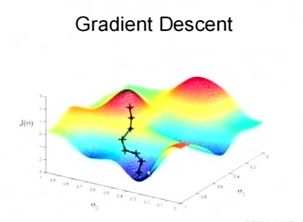A summary about gradient descent
There are three kind of gradient descent now:
1/ Traditional:
Like a people who wants to get down of the hill as soon as possible. Then he/she will find a way that has a big steepness of local place.
The biggest steepness direction is the direction of negative gradient(since the positive gradient represents the direction of increasing fastest).
In this situation, it is:
since the way we walk down the hill here is to change the θ to let the cost function be the lowest.
Once the cost function is convex function, we can get the global optimization.
The walk down is:
a is the learning rate. How big the walk down step is.
2/ Stochastic gradient descent(There is a very good explanation in Quora: https://www.quora.com/Whats-the-difference-between-gradient-descent-and-stochastic-gradient-descent)
In general, the main difference is:
 In this update we showed above, we only use one training sample. So there isn't any sum any more. We just calculate one sample to get the cost function.
In this update we showed above, we only use one training sample. So there isn't any sum any more. We just calculate one sample to get the cost function.
3/ Mini-batch gradient descent
Mini-batch is the compromise of 1 and 2.
Instead of using all the data, it only sum up 100 or a particular amount of data. In order to improve the efficiency of gradient descent when the training dataset is so large.
Reference:
[1] https://www.quora.com/Whats-the-difference-between-gradient-descent-and-stochastic-gradient-descent
[2] http://blog.csdn.net/zbc1090549839/article/details/38149561
[3] http://blog.csdn.net/carson2005/article/details/21093989
[4] http://blog.csdn.net/lilyth_lilyth/article/details/8973972

